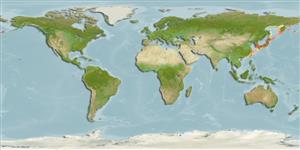>
Perciformes/Zoarcoidei (Eelpouts and pricklebacks) >
Zoarcidae (Eelpouts) > Gymnelinae
Etymology: Gymnelopsis: Gymnelopsis = Gymnel(us) + Greek suffix -opsis, like (that is, similar to), resembling, appearance. Gymnelopsis is like genus Gymnelus (E. Spencer, pers.comm. 09/13).
Environment: milieu / climate zone / depth range / distribution range
Écologie
marin bathydémersal; profondeur 70 - 783 m (Ref. 11954), usually 76 - 200 m (Ref. 50550). Deep-water
Northwest Pacific: Japan and Sea of Okhotsk.
Taille / Poids / Âge
Maturity: Lm ? range ? - ? cm
Max length : 8.9 cm SL mâle / non sexé; (Ref. 11954)
Inhabits shelf and upper slopes.
Life cycle and mating behavior
Maturité | Reproduction | Frai | Œufs | Fécondité | Larves
Anderson, M.E., 1994. Systematics and osteology of the Zoarcidae (Teleostei: Perciformes). Ichthyol. Bull. J.L.B. Smith Inst. Ichthyol. 60:120 p. (Ref. 11954)
Statut dans la liste rouge de l'IUCN (Ref. 130435: Version 2024-2)
Menace pour l'homme
Harmless
Utilisations par l'homme
Outils
Articles particuliers
Télécharger en XML
Sources Internet
Estimates based on models
Preferred temperature (Ref.
123201): 0.7 - 15.3, mean 4.2 °C (based on 82 cells).
Phylogenetic diversity index (Ref.
82804): PD
50 = 0.5312 [Uniqueness, from 0.5 = low to 2.0 = high].
Bayesian length-weight: a=0.01000 (0.00244 - 0.04107), b=3.04 (2.81 - 3.27), in cm total length, based on all LWR estimates for this body shape (Ref.
93245).
Niveau trophique (Ref.
69278): 3.2 ±0.4 se; based on size and trophs of closest relatives
Résilience (Ref.
120179): Milieu, temps minimum de doublement de population : 1,4 à 4,4 années (Preliminary K or Fecundity.).
Fishing Vulnerability (Ref.
59153): Low vulnerability (10 of 100).
